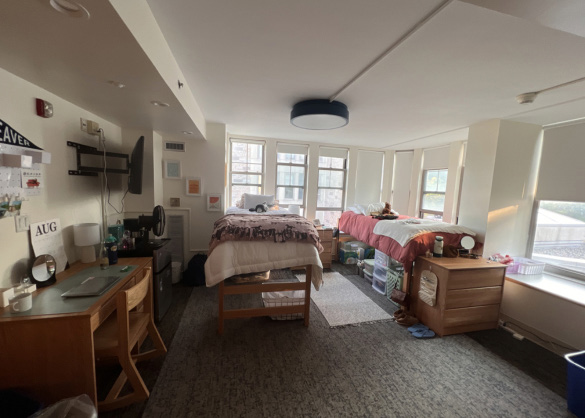Courtesy of Anna Levine ’26
As the final week of August crept up and a greater number of students than ever before boarded planes, stepped onto trains, and packed cars to make their respective journeys to New London, many were left wondering what they would find when they got there. After all, many students did not find themselves in the single, double, triple, or quad they may have expected, but in a common space where students have not previously lived. Roommate numbers varied, with some people having as few as one roommate, and others ending up with as many as five.
As the first few weeks of classes have drawn to a close, fallen leaves have started covering the walkways, and students have settled into life here at Conn, the reality of their living situations, and their mental health impacts, have settled in too. In hearing from four different students, all living in various common rooms and locations, it seems that there is one factor that primarily distinguishes the good situations from the bad, the content students to the unhappy: the number of roommates. Even though a common room may be larger than an average triple or quad, cramming in too many people still makes it difficult for everyone present to feel as if they have time for themselves, or even a space to really make their own. Considering the fact that every student should have a comfortable and safe place to live, and that the other aspects of their lives are inevitably impacted by whether this is available or not, it is very important that Conn listens to its students about these issues. Additionally, it is essential that they do something about situations that do not prove to be good for housing.
Emma Linder, a first-year living in Hamilton House, has only two roommates. She loves her space there, saying, “It is such a nice room and is so spacious.” She and her roommates were able to make the space both functional and “very aesthetically pleasing” through the use of string lights, two mini fridges, a Keurig, a TV, and moving the furniture around (see photos below).
Another first-year, Anna Levine, lives in a common room in Morrison and has had a similarly positive experience so far. She has just one roommate, and loves the amount of space, TV, and the windows. Though she and her roommate haven’t done a lot, they have made the room their own through small details, such as adding a rug in between their beds. In Levine’s opinion, Conn should continue to house people in common rooms in the future “as long as they reduce the number of people in each room,” though hers is “quite spacious” due to only having two people.
In both of these situations, students have more than adequately been given the space to thrive, leaving them much more able to thrive in other areas of their college lives. After all, neither of them are worrying about having enough space, having to climb over furniture to get to their beds or desks, or about feeling overcrowded or like they can never be alone.
Unfortunately, others living in common rooms have not been so lucky. A student who wished to remain anonymous, living in the Katharine Blunt common room, has five roommates, and has come across a lot of negative aspects of living with that many people. They noted the lack of alone time and difficulty having friends over, in addition to their roommates’ different sleep schedules and the amount of noise as problems they have faced. The student also does not find their room to be aesthetically pleasing due the difficulty of decorating with the number of roommates. Unlike Levine, they do not think Conn should continue to house students in common rooms in the future, as it is “impractical and detrimental to [student] mental health to never have privacy or alone time while at school.” As anyone who has spent even a small amount of time in an overcrowded space would know, it gets very irritating, no matter how much you may like who you are with, to constantly be without your own space, and it is not fair on students to force them into an situation where they do not have any.
Another student, who also wished to remain anonymous, has faced some of the same problems living in a common room, though they have been able to decorate with the use of posters and “little knick knacks.” While they said they have trouble finding time to be alone, they have been able to make their own space and think that their roommates and them have made the best of their living situation. They also feel that their situation is better space-wise than some others, such as forced triples.
Overall, it seems that the use of common rooms as living situations is something that can be made doable within reason– as long as they are not overcrowded to the point where the lack of space is detrimental to student mental health. Given the experiences of students with many roommates versus only one or two, if Conn continues to use common rooms as housing spaces, it should not be in place of other solutions, but as a supplement to them instead.









